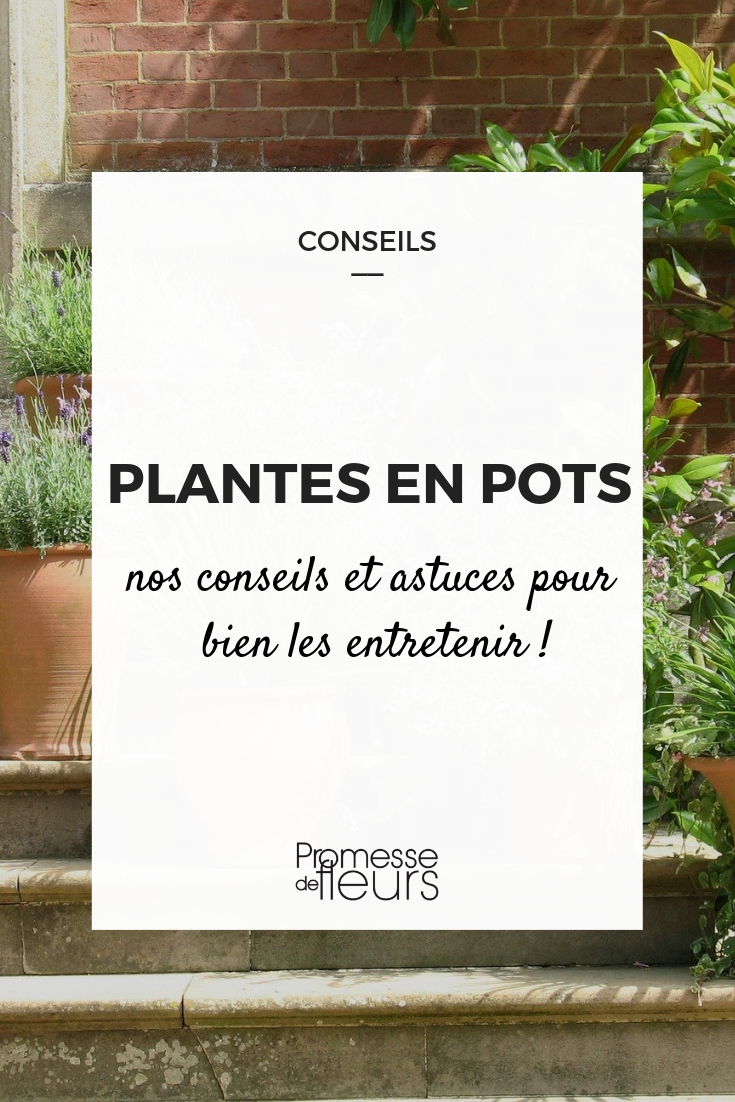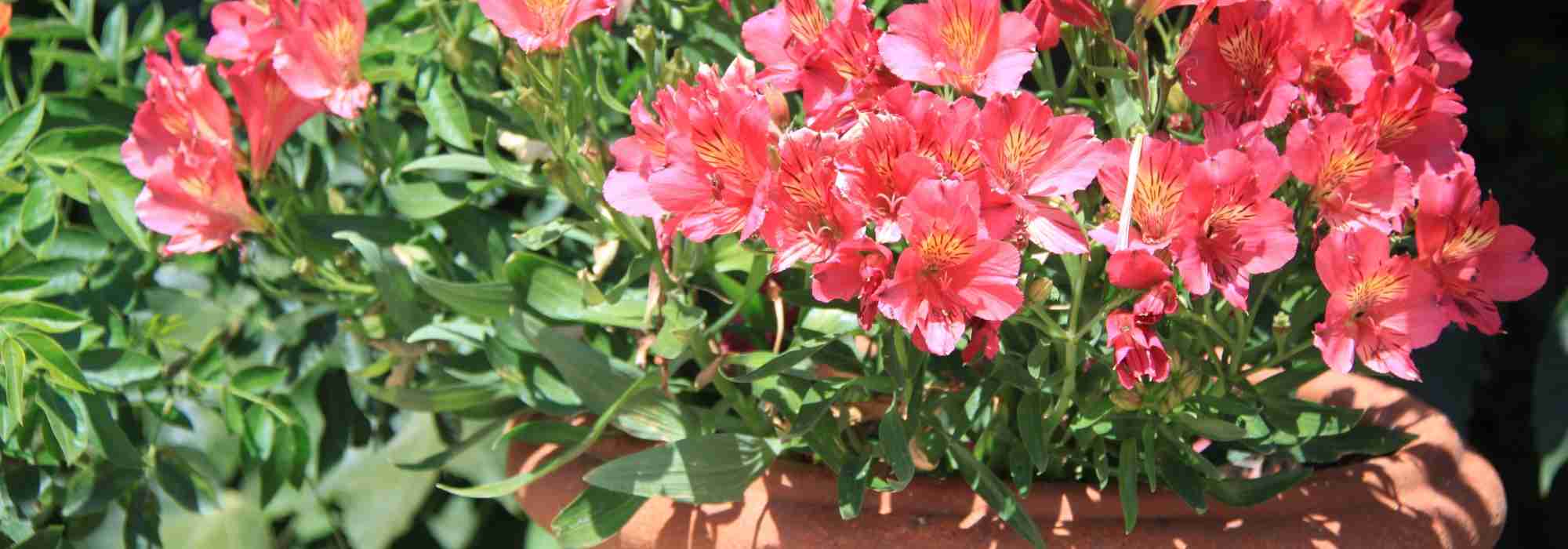
Potted plants: cultivation, maintenance and care
Tips and tricks
Contents
Pots and other planters allow you to bring a piece of nature to decorate a terrace, balcony, courtyard, or simply a windowsill. In the garden, growing plants in pots also enables you to choose slightly tender plants that can be sheltered during winter.
Container gardening is more demanding than growing in open ground and requires more attention. Choosing the appropriate container, feeding, watering, wintering, pruning, and care, find all the tips to follow in our article to enjoy your young plant in a pot and keep it in great shape for many years!
How to choose the right pot for my plants?
Pots, depending on their sizes, shapes, materials, or colours, do not present the same characteristics.
In a large pot, the soil dries out less quickly, and plants have access to more nutrients and space to develop their roots. However, it is important to match the container to the age and development of the plant. As a general rule, it is better to choose a container that is slightly larger than the one in which the plant was growing, and when it becomes cramped, to repot it into a larger one.
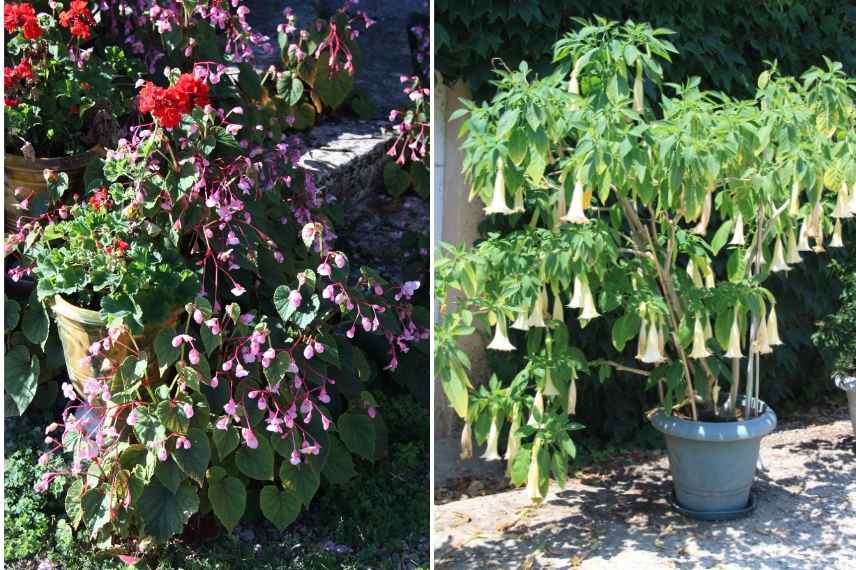
Pelargonium and begonia in terracotta pots / Brugmansia in a plastic pot
Depending on the chosen material, the advantages and disadvantages vary:
- Terracotta (unglazed) ensures better root respiration but its porosity leads to greater evaporation. This material is well-suited for plants that prefer drier soils. We appreciate terracotta for its authentic and natural appearance, but it is often quite expensive, heavy, and fragile. Some cheaper pots do not withstand frost, making them more suitable as cache-pots.
- Synthetic materials (plastic, fibreglass, PVC…) offer numerous shapes and colours, some even capable of diffusing ambient light. Lightweight and sturdy, some are very inexpensive and they withstand frost well. More ‘hermetic’, they are suitable for plants that prefer moist soil.
- Wood is valued for its nobility and warmth. Less heavy than terracotta but more so than synthetic products, wooden containers are treated to withstand outdoor use for a certain period but are not eternal. Remember to maintain them to prolong their lifespan.
- Stone is solid, retains heat well, and we love its appearance, but it is a heavy material, difficult to handle and it can suffer from frost.
- Metal and its derivatives allow, like plastic, for original shapes and integrate well into contemporary designs. However, they heat up quickly when placed in the sun and insulate poorly from the cold in winter.
Also to consider:
- Generally, dark colours retain more heat than lighter ones.
- Bulbous shapes (where the top of the pot narrows) are beautiful but impractical. Reserve them for annuals, easy-to-divide perennials, or use them as cache-pots. With this shape, the roots can be easily damaged when repotting.
- Narrow shapes dry out more quickly and are more suitable for plants that prefer dry soil.
- Balcony planters have a limited volume of soil and are best used for ephemeral and seasonal decorations as well as small herbs or bulbs.
- Except for aquatic plants, ensure that the pot has a drainage hole. If it doesn’t, drill one yourself. This prevents the roots from sitting in water and rotting. Also, place drainage material at the bottom of the pot (gravel, clay balls…), covered with a geotextile fabric to prevent the soil from blocking the drainage.
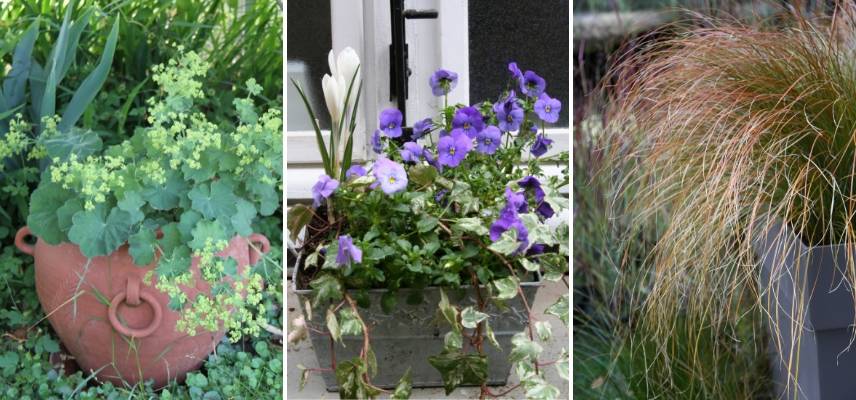
Different shapes of pots: bulbous (best reserved for annuals), planter, and tall narrow pot (perfect with Carex testacea ‘Prairie Fire’)
How to choose the right substrate for my potted plants?
In both open ground and pots, each plant requires a specific soil.
Some bushes or perennials, such as those referred to as ‘heath’ for example, require an acidic potting mix that is cool, while also providing satisfactory drainage. It is out of the question to fill the container with garden soil if it is heavy and alkaline. Conversely, a calcareous soil is necessary for other plants, such as boxwoods for instance. Ignoring these specifics can lead to disappointments, potentially resulting in the death of the plant.
Installing a layer of drainage at the bottom of the pot is often recommended. Again, it depends on the plant you are installing. Some require consistently cool or even moist soil. A potting mix with high water retention, combined with placing a saucer under the pot, provides an extra safety net that your resident will appreciate. And what about aquatic plants, which need to have their roots submerged in water at varying depths permanently? This scenario necessitates using a pot without a drainage hole and a heavy, clayey substrate that won’t disperse. Aromatic plants and Mediterranean species are often very undemanding in terms of water, and the potting mix chosen must be draining to prevent the roots from rotting.
When selecting a particular plant, ensure you understand its needs and install it in a potting mix that guarantees the best chances for enjoying healthy foliage, generous flowering, and this for many years to come.
You can find many types of potting mixes: horticultural, for roses, for geraniums, for lemon trees, etc. This choice can leave you a bit perplexed.
To decipher the composition of these different growing mediums and select according to your needs, consult our guide ‘How to choose a good potting mix for sowing, repotting, and cultivating?’.
What fertiliser and how to repot potted plants?
Regularly feeding potted plants
In a pot, the substrate becomes depleted. Plants draw the nutrients they need from it, and the watering gradually leaches this ‘artificial’ soil. It is therefore important to regularly feed your plants, according to their needs.
For hungry plants, incorporate a slow-release fertiliser into the potting mix. It usually comes in the form of sticks, cones, or beads. You can also add a liquid fertiliser to the watering (follow the dosages indicated on the packaging), to be applied approximately every 10 days, only during the growth and flowering periods. Always proceed on a moist potting mix, to avoid burning the roots. Again, check the plant’s needs before any fertiliser application.
Repotting or topping up a potted plant
A plant grows, even in a pot. If its branches encounter no obstacles, the growth of its roots is, however, limited by the volume of soil, which also becomes impoverished. There comes a time (on average every 3 to 4 years) when you need to repot, or at least top up. Do this from the end of winter to the beginning of spring, avoiding frost periods.
Certain signs indicate that it is time to intervene:
- The level of the substrate has dangerously dropped
- The roots are visible on the surface or have filled all available space
- The roots have grown through the drainage holes
- Your plant is looking less attractive, flowering less, and seems to be struggling even though you have been feeding it regularly for several years.
Topping up involves scraping off the top few centimetres of soil (minimising damage to the surface roots) to remove the exhausted potting mix and replace it with fresh substrate, to which you may add slow-release fertiliser. Water afterwards. Prefer this operation if the pot is too large to handle. In all cases, avoid burying the collar (the junction between the aerial part and the roots).
Repotting provides a renewed environment for the plant.
Remove it from its container and gently scrape some soil from around the roots (without damaging them). Be careful, some plants do not appreciate having their delicate root system disturbed. Again, inform yourself before proceeding. A light trimming of the small roots can be beneficial. For perennials, this is also an opportunity to divide them. Ideally, choose a container that is slightly larger than the previous one and replant in a fresh potting mix, as you would for an initial planting. Never reuse impoverished potting mix!
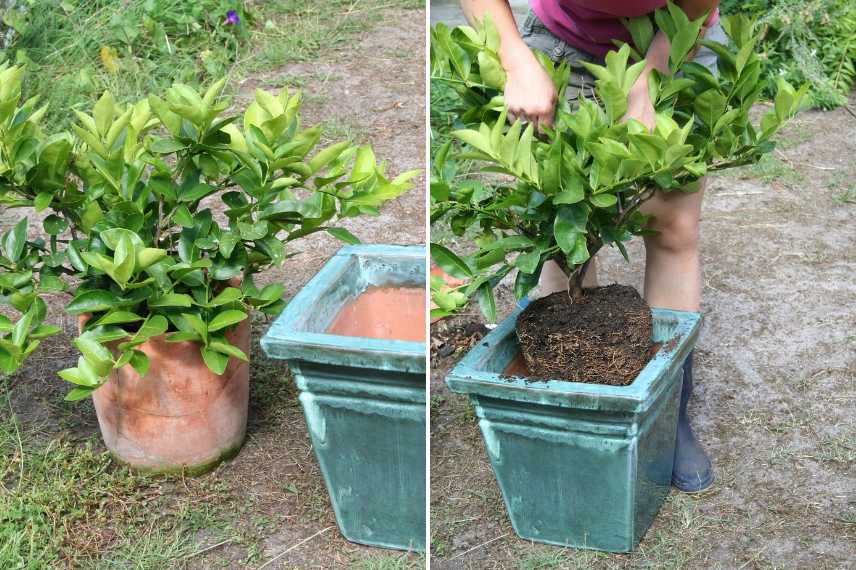
Repotting a lemon tree
If you are placing several plants in the same container, ensure they have the same requirements (exposure, soil, water needs…).
How to water potted plants properly?
The substrate dries out faster in pots, but it is essential to water wisely, depending on the plants, weather conditions, and seasons. A succulent plant or Mediterranean plant, for example, does not need as much water as a hydrangea!
A thirsty plant may show certain signs (leaves curling inwards, stems drooping, foliage turning brown, drying out, falling off…), although some of these can also indicate overwatering or diseases. To avoid this, stick your finger into the potting soil to assess its dryness. For some plants, consistently moist soil is necessary. For others, you should wait until the top few centimetres are dry before watering.
We cannot stress this enough: research the specific needs of each plant to understand its moisture requirements, or risk losing it, even with the best intentions.
Water early in the morning or late in the evening. Prefer small daily waterings to a weekly ‘drowning’. When water starts to flow out of the drainage hole, there is no need to continue.
A saucer can create a water reserve for the more ‘thirsty’ plants, unless your pot is already equipped with a water reservoir.
Installing an automatic watering system takes the hassle out of water management. A drip irrigation system allows you to deliver the necessary amount to each plant. Connected to a timer, you can even go on holiday with peace of mind. Otherwise, use our tips to manage the heat during your absence.
Water-retaining agents allow for longer intervals between waterings and help keep the substrate cooler.
Mulch the surface of your pots to limit evaporation.
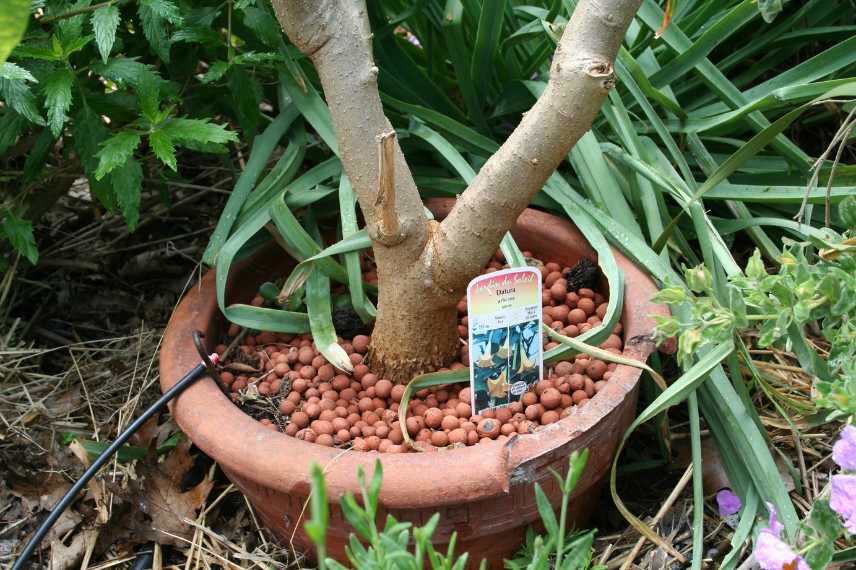
Brugmansia in a pot benefiting from a mulch of clay balls and a drip irrigation system
Organise your space so that the taller plants provide shade for the smaller ones.
Use the right plants in the right place. Shade plants do not survive long on a terrace scorched by heat all day.
If a pot is too dried out (in extreme cases, a gap may even form between the substrate and the edges of the container), a standard watering is usually not sufficient as the water escapes without being absorbed by the roots. The ideal solution is to place the pot (if its size allows) entirely in a basin of water for several hours.
How to protect potted plants from the cold?
Plants in vegetative rest (generally between November and March) have lower needs. In addition to stopping fertiliser application, watering should also be reduced. For plants that spend winter outdoors, natural rainfall is usually sufficient. However, in case of severe deficit, you should water, always outside of frost periods.
Protect the more delicate ones with a few simple tips:
- Move them close to a wall of the house to gain a few degrees (avoid the East to prevent harmful frost and thaw cycles)
- Remove the saucers or turn them upside down. Place the pots on top (or on small blocks) to insulate them from the cold soil.
- Install a thick mulch (such as dead leaves) and wrap with a winter cover. Double or triple the thickness in case of severe cold. Remember to remove the coverings during warm spells. The pot itself can be surrounded by cardboard or felt to limit the cold’s effect on the roots.
- Bring the most fragile plants indoors, to a bright and cool place but frost-free (garage with windows, conservatory, greenhouse…). Just ensure that the substrate does not become completely dry. A light monthly watering is sufficient in most cases.
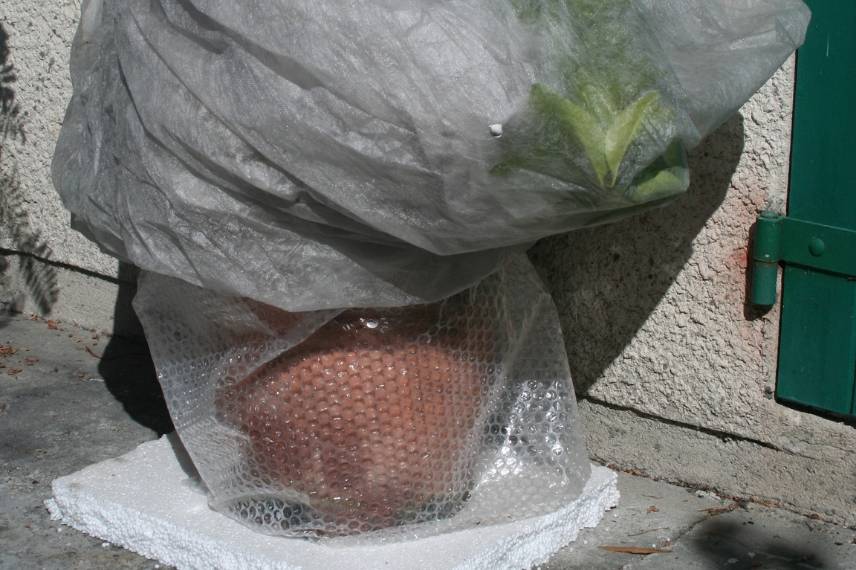
Winter protection for a potted lemon tree
How to prune potted plants?
- Prune the bushes according to the recommended pruning periods for each plant, as if it were growing in open ground. On this subject, consult our two guides: pruning of spring-flowering bushes and pruning of summer-flowering bushes.
- Pinch the perennials and annuals at the beginning of growth to encourage them to ramify.
- Regularly remove faded flowers.
- Divide the perennials during a spring repotting.
How to care for potted plants?
Some diseases can arise, encouraged by the close proximity of plants (fungi, pests…).
- Do not overcrowd your pots: air must circulate between the plants
- Feed and water your plants according to their needs. When in good shape, they are better able to resist pathogenous agents.
- Cut and remove diseased parts. Disinfect your pruning shear as soon as you change plants.
- If necessary, treat preventively with natural preparations such as nettle manure, fern, horsetail or comfrey, or with organic productssuitable, environmentally friendly.
- Wash and disinfect thoroughly any pot intended for a new plant, to avoid transmitting diseases.
- Subscribe!
- Contents
